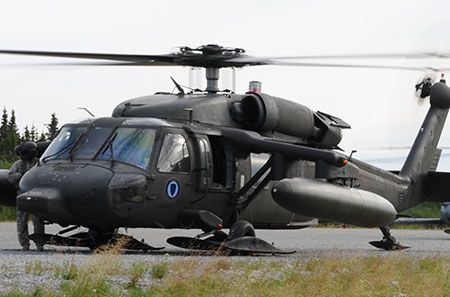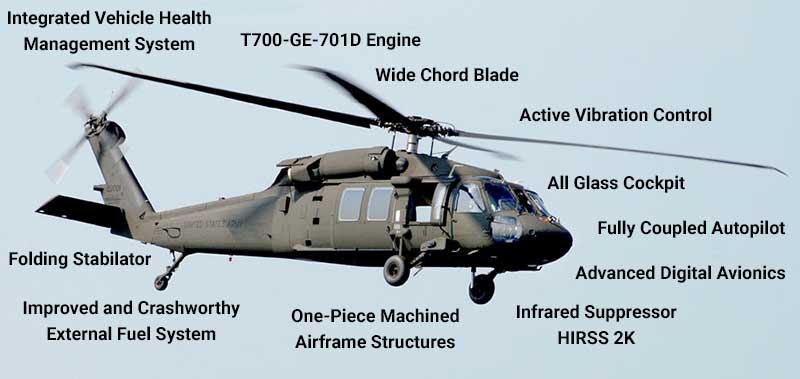UH 60 Helicopter Maintenance: A Comprehensive Overview for Pilots
UH 60 Helicopter Maintenance: A Comprehensive Overview for Pilots
Blog Article
Recognizing the Mechanics and Engineering Behind Uh 60 Helicopters
The UH-60 helicopter, typically referred to as the Black Hawk, stands as a peak of modern rotorcraft modern technology, personifying a mix of durable design and complex technicians. From its beginning to its current models, the development of this airplane showcases a blend of advancement and usefulness. As we peel off back the layers of the UH-60's style, a world of elaborate systems and thorough engineering emerges. Comprehending the technicians and engineering behind this functional aircraft reveals a realm where accuracy meets power, and where each part plays a vital role in accomplishing trip.
Background of UH-60 Helicopters
The background of UH-60 helicopters traces back to the late 1970s when the USA Army sought a versatile and advanced energy helicopter to replace its aging fleet. In response to this need, the Sikorsky Airplane Company established the UH-60 Black Hawk helicopter. Introduced in 1979, the UH-60 quickly came to be a staple in armed forces operations due to its remarkable capacities.
The UH-60 was created to master a selection of objectives, including army transport, clinical emptying, digital war, and unique operations. Its capability to adjust to different duties made it an important possession to the united state Army and other army pressures worldwide
Throughout the years, the UH-60 platform has undergone numerous upgrades and variations to boost its performance and equal advancing mission needs. These helicopters have seen substantial service in disputes such as the Gulf War, Afghanistan, and Iraq, showcasing their dependability and versatility in diverse functional environments. The UH-60's abundant background is a testament to its long-lasting legacy as a leading energy helicopter.

Engine and Power Solutions
Using advanced propulsion technology, UH-60 helicopters are outfitted with sophisticated engine and power systems to guarantee optimal efficiency and dependability in a range of functional situations. The UH-60, commonly referred to as the Black Hawk, is powered by 2 General Electric T700-GE-701D engines, each with the ability of supplying up to 1,940 shaft horsepower. These turboshaft engines give the needed thrust for the helicopter to perform its objectives effectively, consisting of troop transportation, medical discharge, and combat assistance.

Rotor System and The Rules Of Aerodynamics
Just how do the rotor system and the rules of aerodynamics of UH-60 helicopters contribute to their operational efficiency and flight capabilities? The rotor system of the UH-60 helicopter plays a vital duty in supplying lift and propulsion. The UH-60 features a four-bladed, totally verbalized rotor system that enables high ability to move and stability throughout flight. This layout allows the helicopter to perform a wide variety of missions, from transportation and medical emptying to combat procedures.
Aerodynamics likewise play a key function in the efficiency of UH-60 helicopters. The streamlined fuselage and blades blade go to my blog design minimize drag, permitting the helicopter to achieve greater speeds and much better gas efficiency. The aerodynamic layout of the UH-60 also contributes to its capacity to run in diverse environmental problems, consisting of high altitudes and warm temperature levels.
Avionics and Trip Control Solution

In its detailed control with the blades system and aerodynamics of UH-60 helicopters, the avionics and flight control systems form an essential network of technologies shaping the airplane's functional capacities. In the UH-60, these systems consist of digital displays, interaction radios, General practitioner navigation, weather radar, and auto-pilot systems.
The trip control systems of the UH-60 are accountable for translating the pilot's inputs right into the proper modifications to the rotor system, making certain steady flight and ability to move. These systems include hydraulic actuators, servos, and computers that function together to control the tail and primary blades, along with other trip control surfaces. By specifically handling the helicopter's flight characteristics, these systems enable pilots to execute a variety of objectives, from transportation and search-and-rescue to battle procedures, with precision and self-confidence.
Role and Applications in Air Travel
The function and applications of avionics and flight control systems in aviation are important to ensuring the effective and secure procedure of aircraft, consisting of UH-60 helicopters. Avionics systems in UH-60 helicopters encompass a variety of digital systems that help in navigating, interaction, surveillance, and controlling different airplane functions. These systems include electronic displays, autopilot systems, interaction radios, general practitioner navigation devices, and climate radar. Trip control systems play a critical role in navigating the helicopter airborne, keeping security, and guaranteeing exact activities. The fly-by-wire technology utilized in contemporary UH-60 helicopters converts pilot inputs right into digital signals, which are then interpreted by the flight control computers to change the airplane's control surface areas. In addition, these systems include security features such as autopilot settings, terrain understanding alerting systems, and security augmentation systems to improve the general security and operational capacities of the UH-60 helicopters in various missions, including army transport, medical discharge, search and rescue, and aerial firefighting.
Conclusion
In conclusion, the UH-60 helicopter is a versatile aircraft with a rich background and progressed design. Its engine and power systems, blades system, the rules of aerodynamics, avionics, and trip control systems all function with each other to make it a reliable and efficient maker.
In its complex control with the blades system and aerodynamics of UH-60 helicopters, the avionics and flight control systems form a critical network of modern technologies forming the airplane's investigate this site operational capabilities.The flight control systems of the UH-60 are liable for converting the pilot's inputs right into the suitable adjustments to the rotor system, ensuring secure trip and maneuverability. Avionics systems in UH-60 helicopters encompass an array of digital systems that aid in navigation, interaction, surveillance, and controlling different aircraft features. Furthermore, these systems incorporate security features such as auto-pilot settings, terrain understanding advising systems, and security augmentation systems to improve the general safety and functional this contact form abilities of the UH-60 helicopters in different missions, consisting of army transport, clinical discharge, search and rescue, and aerial firefighting.
Its engine and power systems, rotor system, the rules of aerodynamics, avionics, and trip control systems all function with each other to make it a effective and reliable maker.
Report this page